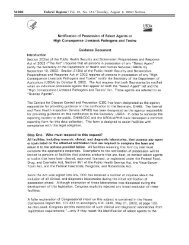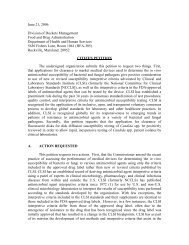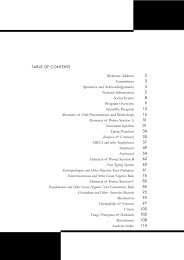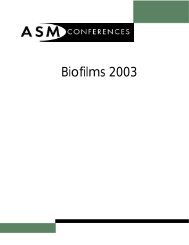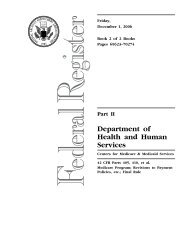Burkholderia mallei and B. pseudomallei - Microbiology - American ...
Burkholderia mallei and B. pseudomallei - Microbiology - American ...
Burkholderia mallei and B. pseudomallei - Microbiology - American ...
Create successful ePaper yourself
Turn your PDF publications into a flip-book with our unique Google optimized e-Paper software.
I. GENERAL INFORMATIONA. Description of organisms<strong>Burkholderia</strong> <strong>mallei</strong> is a nonmotile, aerobic gram-negative coccobacillus, whichmay or may not be oxidase positive or grow on MacConkey agar. <strong>Burkholderia</strong>pseudo<strong>mallei</strong> is an oxidase-positive, aerobic gram-negative bacillus that is straightor slightly curved. The organism will grow on most st<strong>and</strong>ard laboratory media, suchas sheep blood <strong>and</strong> chocolate <strong>and</strong> MacConkey agars, <strong>and</strong> it produces a characteristicmusty odor (13). The recent sequencing of the genomes of these two organismssuggest that B. <strong>mallei</strong> is a recently evolved clone of B. pseudo<strong>mallei</strong>. B. <strong>mallei</strong> hasa smaller genome which makes it much less environmentally adaptable (14).B. History<strong>Burkholderia</strong> <strong>mallei</strong> is the etiologic agent of gl<strong>and</strong>ers, a febrile illness typically seenin equines: i.e., horses, mules, <strong>and</strong> donkeys (2). During World War I, the Germanmilitary used this agent as a biological weapon against horses <strong>and</strong> mules, theprimary form of transportation during that conflict (4). Naturally occurring humaninfection is likely due to exposure to an infected animal. The last naturally acquiredhuman case of gl<strong>and</strong>ers in the United States was seen in 1945 (2). A case oflaboratory-acquired gl<strong>and</strong>ers occurred in 2000 (2).<strong>Burkholderia</strong> pseudo<strong>mallei</strong> is an environmental organism found in soil <strong>and</strong> water<strong>and</strong> is most likely obtained naturally by direct contact with, or aerosols from,environmental sources. For many years, this bacterial species as well as B. <strong>mallei</strong>were classified as a member of the genus Pseudomonas, but in 1992, they werereclassified into the genus <strong>Burkholderia</strong> (28). B. pseudo<strong>mallei</strong> was first reported ascausing human infections in 1911 by Whitmore from individuals living in Rangoon,Burma (now Yangon, Myanmar) (27) <strong>and</strong> in earlier medical literature was called“Whitmore’s disease.” These patients were described as septicemic withwidespread abscesses in the lungs, liver, spleen, <strong>and</strong> kidneys. <strong>Burkholderia</strong> was oneof the first organisms reported as a cause of infection in intravenous drug users (27).Because the organism was thought to cause a gl<strong>and</strong>ers-like illness in humans, it wascalled “pseudo<strong>mallei</strong>” by Stanton <strong>and</strong> Fletcher (8). The gl<strong>and</strong>ers-like disease inhumans due to B. pseudo<strong>mallei</strong> is now referred to in the medical literature as“melioidosis,” from the Greek word “melis,” which was the term for distemper indonkeys (19). It was found to cause disease in soldiers from both Australia <strong>and</strong> theUnited States during the Vietnam War <strong>and</strong> has been referred to as the “Vietnamtime bomb” because the disease, much like tuberculosis, can reactivate afterremaining latent for decades (8).Two organisms which are very similar to B. pseudo<strong>mallei</strong> phenotypically haverecently been described in the literature (9,10). <strong>Burkholderia</strong> thail<strong>and</strong>ensis is anenvironmental organism found in rice paddy water <strong>and</strong> soil in Thail<strong>and</strong>. It has beenshown to be of comparatively low virulence in animal models <strong>and</strong> has beeninfrequently reported to be a cause of human disease (9,10). In the clinicallaboratory, it is most easily differentiated from B. pseudo<strong>mallei</strong> on the basis of its5



